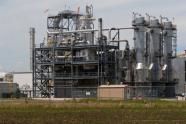Is Waste Energy Sustainable?
More wind and solar possible, say advocates

In 2010, line losses in the U.S. grid cost about $26 billion; the power generation to feed those losses emitted 160 million tons of carbon dioxide. Those line losses rise dramatically during peak hours and tie up a huge amount of generation and transmission capacity. That limits new wind and solar generation access.
Local waste energy recycling or WER projects can significantly reduce the line losses, free existing transmission to carry wind, provide less expensive wind and solar backup, and generate sustainable base load power.
Line losses rise during peak system hours. Imbalance between the two types of reactive forces created by electric loads and transmission also increase line losses. Conventional approaches – building more transmission lines and offsetting inductive forces with large capacitor banks – have limited effectiveness.
All local generation cuts line losses by reducing load, and any spinning generator could supply balancing reactive force, if grids offered appropriate compensation. Local waste energy recovery generation can provide both of these services and also produce sustainable energy, using no incremental fuel and emitting no incremental pollution. Inducing WER deployment would thus free wires to carry more wind power.
Carnegie Mellon studies show that 1 megawatt-hour of local generation providing active grid support could displace up to 1.45 MWh of remote generation on average, and up to 2.25 MWh of peak generation and transmission capacity.
Why don’t grid operators encourage new WER projects? The answers have more to do with regulatory history than today’s reality. Before deregulation, U.S. monopoly-protected utilities resisted all distributed generation, assuming that the power would be sold to the host, reducing utility sales and profits.
All power will indeed flow to the nearest user, but utilities could purchase the power and keep the retail load. Also, traditional ratemaking rewarded utilities for deploying more capital – building more wires and generation, but did not reward efficiency. Today’s rate commissions may allow utilities to profit from efficiency, and/or penalize utilities for continued inefficiency.
What is Waste Energy Recycling?
Waste energy from industrial processes and from thermal electricity generation can be recycled to provide electricity and useful thermal energy. WER projects substitute capital and intellectual resources for fossil fuel and associated pollution.
The useful industrial waste energy comes from hot exhaust from glass, cement and silicon production -- all to drive steam generators. Electric generation waste, meanwhile, energy emerges as low-grade thermal energy equal to about two thirds of the energy in the fuel and is thrown away.
Appropriately sized local generation plants can recycle most of this waste heat to displace steam boiler fuel. Denmark produces over 50% of total power this way, versus only 8% of generation in the U.S. This largely explains why the Danish system is 50% efficient while the U.S. system is only 33% efficient. Increasing U.S. efficiency would cut power costs and improve U.S. competitiveness.
WER projects must be local, near the waste energy supply or thermal use, since heat and waste energy do not travel well. Almost always, the facilities producing waste energy also need electricity, so WER generation goes directly to users and unloads transmission lines, reducing line losses. WER generation can provide active power support to balance reactive loads and further reduce line losses. Recent Department of Energy studies identify roughly 200,000 megawatts of potential U.S. WER generation.
Transmission Capacity Limits Wind and Solar
The U.S. has no spare transmission for wind and solar. The National Renewable Energy Labs found that “approximately 10,000 miles of additional high voltage lines over the base case would be needed, costing about $50 billion.”
No one wants new transmission lines in their back yard, which makes new lines hard to permit. During the last decade, the U.S. added only 620 miles of new transmission. At this pace, it will take two centuries to build enough transmission to enable 20% wind, before any further load growth.
Installing half of the estimated potential WER capacity would help free up much needed capacity. That makes room for more wind and solar. Here’s why: To keep generation and load in balance, grids need spinning reserves – operating plants that can instantly increase (or decrease) generation. To provide spinning reserve, utilities operate gas turbines at part load.
A recent ICF study says new wind will require 33,000 megawatts of spinning reserve over the next 15 years. Operating these turbines all day at part load will add costs to wind and solar power. Deploying these turbines in WER projects could avoid these costs.
For example, a WER project generating 40 megawatts with a 100 MW gas turbine could supply all of the thermal energy to an ethanol plant, a packing plant, or a large commercial complex, saving money and pollution, and still supply 60 more MW supply spinning reserve.
WER projects can increase U.S. energy efficiency, add new sustainable generation, free transmission wires to carry more power from solar and wind, and reduce the cost of clean energy. Regulators can induce these many benefits by using some of the savings to induce deployment of WER plants, thus creating benefits for all stakeholders. WER projects can speed the path to affordable, sustainable energy.
Tom Casten is chair of Recycled Energy Development in Westmont, Illinois.
Copyright © 1996-2010 by CyberTech, Inc. All rights reserved.
To subscribe or visit go to: http://www.energycentral.com
To subscribe or visit go to: http://www.energybiz.com